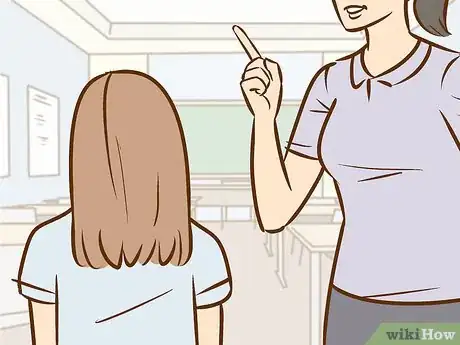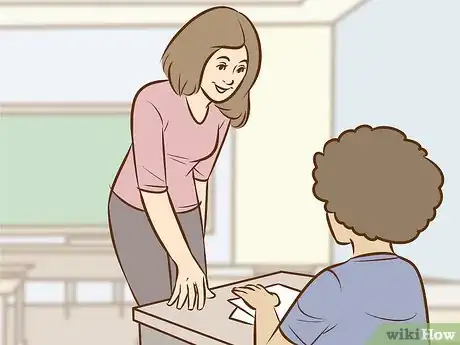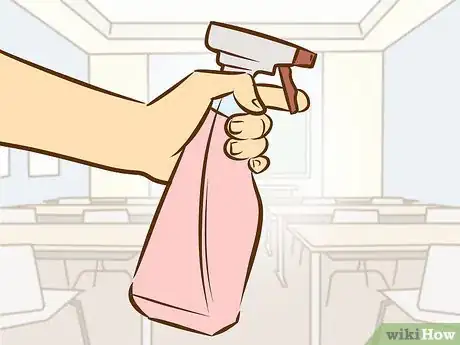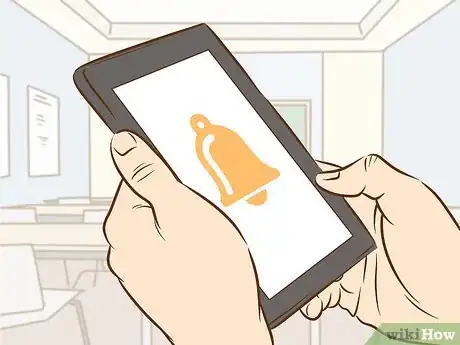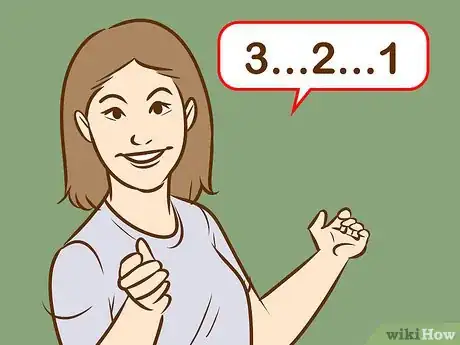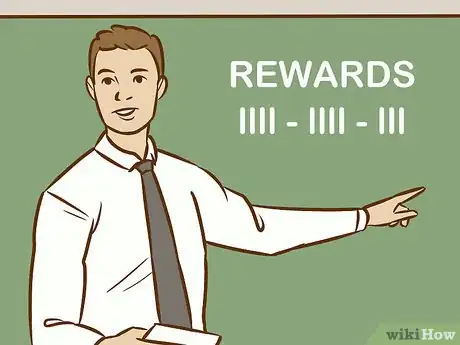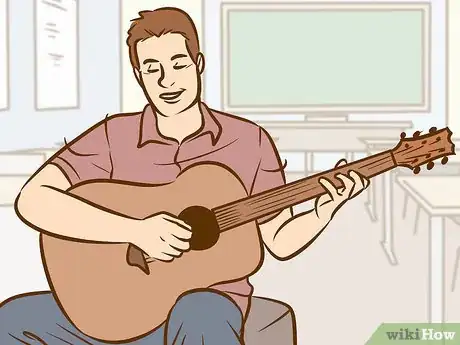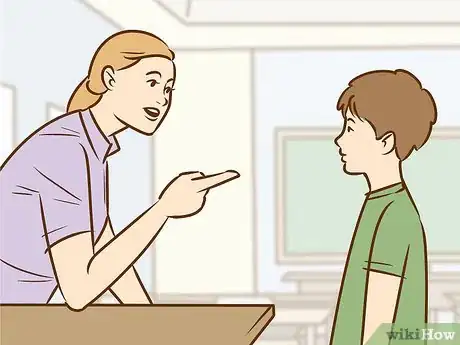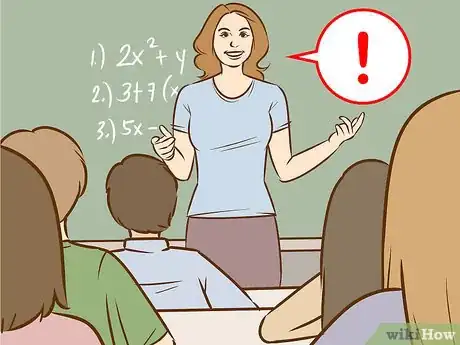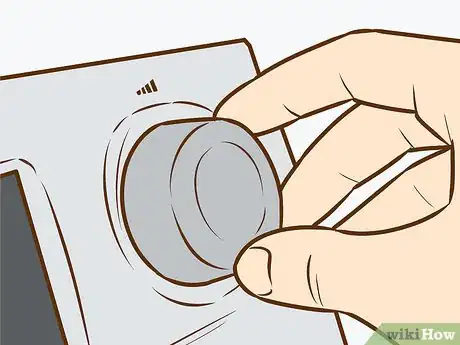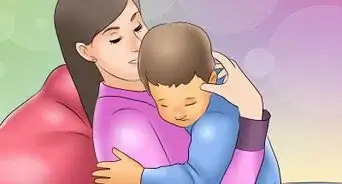This article was co-authored by Courtney Copriviza. Courtney Copriviza is an Elementary School Teacher based in Maui, HI. Courtney specializes in elementary education, classroom management, and social and emotional development. She holds a BA in Communication with a minor in Urban Education and an MA in Teaching from Santa Clara University. Courtney has also taught high school in Madrid, Spain. She is a member of Kappa Delta Pi International Honors Society in Education.
This article has been viewed 106,707 times.
Working with a large group of kids can be a lot of fun. However, there may be some times when the group you are working with gets a bit too loud or out of control. While this can be aggravating, it's best to keep your cool and try introducing some effective methods to send the message that it's time to be quiet.
Steps
Using Simple Steps to Keep Kids Quiet
-
1Stay calm. Although it can be stressful to be in a room full of loud children, getting aggravated will only make things worse. If the children see that you are becoming annoyed or you start yelling, the situation will likely only become louder and out of control. Always stay calm and act in control, even if you don't feel like you are.[1]
- Try taking a deep breath and counting to 3 in your head before you do or say anything.
-
2Get everyone on board and stay consistent. Whether you work alone or with others, you will want to keep your commands and rules consistent.[2] Keeping things consistent can help your kids know what's expected of them and when it's expected. Whenever you are trying to keep a group of kids quiet, always use the same commands and consequences to help make your directions clear. [3]
- If you work with other instructors, have them use the same commands and consequences that you do.
- Make sure that everyone is phrasing “no’s” in positive terms. For example, instead of saying, “No running!” everyone could say, “Use walking feet!”
- Avoid changing your instructions to keep quiet. Try to quiet the kids down using the same methods to make them routine and familiar.
- Try to use the same methods in different situations. For example, if you have a key word that means "be quiet", you'll want to use it in the classroom, on a field trip or any other situation you might need to.
- Invite your students to help you come up with 3-4 classroom rules that they think are most important. Keep this list of rules short and concise, so you can keep the kids on track and on task.[4]
Advertisement -
3Separate disruptive children. Often times, it's only a few children who are causing the entire group to act unruly. If you can identify and separate kids who seem to make trouble or act inappropriately when they are together, you can help control the group's behavior. Always try to separate disruptive individuals to help keep things calm.[5]
- Try standing near the kids who tend to act out the most when you are addressing the class.[6]
-
4Cater to the age group. Not all methods will work as well as others, depending on the age group of the children you are working with. You'll need to use the right methods on the right age group to help keep them quiet. Always think about the ages of the kids you are trying to keep quiet and use the best methods with them.[7]
- Younger kids respond well to playful ways of quieting down.
- Older children seem to respond well to group rewards or consequences.
-
5Know how to regain control over the kids. Even though you may have some great methods that usually work to keep kids quiet, they may not always work. Maybe the day is a particularly exciting one or the kids are just not ready to quiet down. If you feel that you've lost control over your class and the usual techniques for quieting down aren't working, try some of these basic methods to help you regain control:
- Slowly increase the level of consequences. For example, if you are using a point system, take away more and more points for every minute the kids are too loud.
- If one child is responsible for the disruption, send them out of the class and speak with them apart from the class.
- Changing the activity you are doing can shift the focus onto something other than the disruptive activity they are engaged in.
- Once your kids have started to quiet down, have them put their materials away and simply sit in silence. Wait for at least five minutes in silence before resuming.
- You could also try a calm response technique with your students, such as "1, 2, 3, eyes on me, 1, 2, 3, eyes on you."[8]
Keeping Elementary School Children Quiet
-
1Have a special noise. It can be helpful to have a special noise that signifies it is time to be quiet. The noise itself can be anything you might like to use. You'll need to introduce the noise as being the “quiet sound” and only use it when you need your kids to settle down. Work with your kids to let them know that the quiet sound is something fun and something to pay attention to. [9] [10]
- You could try sounding a chime to indicate it's quiet time.
- Practice by having your kids get noisy and then seeing how fast they can be quiet after you make the noise.
-
2Create a “quiet spray”. It can be a fun idea to create a “quiet spray”, using a simple misting water bottle. Fill the bottle up with water and tell the kids that it is a “quiet spray” and that they need to be silent whenever the spray comes out. Have fun with it, giving it a sense of being magical or special, to help engage the kids and manage noise levels.[11]
- Be careful not to make the spray a motivation for the kids to act out.
- Never aim the spray at 1 child in particular.
-
3Check out some helpful apps. There are many apps available for your phone or tablet that can be helpful when keeping a group of young kids quiet. These apps listen to noise levels in the room and emit a tone when they get too loud. This noise can be a signal to kids that they need to quiet down until the app stops making the noise.[12]
-
4Use a countdown. If your group of children is getting too loud, you can try counting down with them. Tell the kids that it's time to do a quiet countdown, starting at ten and getting quieter as you countdown to one. Once the countdown is over, pick up where you left off and resume your lesson.[13]
Working to Keep Middle Schoolers Quiet
-
1Offer group rewards. It can be helpful to offer group incentives when dealing with noise issues. You might offer rewards for being quiet or penalties for being too loud. Make sure that the rewards or penalties are based on individual's actions to make all students feel responsible for the others success.[14]
- For example, if one student is being too loud, you can add a negative point to the classes overall “rewards score”.
- If everyone quiets down quickly after you ask them to do so, try adding points to the classes score.
- Try using rewards in the form of a game, such as Jeopardy, so that you can reward kids for providing correct content information.
-
2Use a specific hand gesture. Middle school children can respond well to special hand signals when they are being too loud. Try coming up with a fun hand signal and telling the kids that it means it's time for silence or that they are being too loud. Throw up the hand signal and wait for everyone to calm down before proceeding.[15]
- Make sure to practice your special signal with the group of children.
-
3Have a code word. You can use a code word that will let the kids know when they are being too loud. The word itself can be anything you would like to use. Tell the kids that if they hear the code word, it's time to quiet down. Make sure to only use the codeword when the kids are being too loud.[16]
-
4Play some music or sing a song. You can try using a short song to get some of the kid's energy focused and redirected, before having them settle down for work. Play or sing a song for a few seconds and have them sing along or listen. Tell them that by the time the song is over, they have to be quiet and ready to work.[17]
Having High School Students Stay Quiet
-
1Take break time away. Older students will place a high value on their free time. If a student or students are not quieting down, you can try making them stay after class or during a break. This penalty, or threat of it, should be enough to get most students to settle down and stay quiet when it's time to work.[18]
-
2Use call and response to redirect the class’s attention. You can try implementing a call and response practice with your kids to help them quiet down. Get in some practice by being noisy, doing the call and response and then making sure that they quiet down after. Strive for complete silence while practicing. The next time your kids get too loud, issue your call and wait for their response, followed by silence.[19]
- For example you might say "What are we?" and have your students whisper "Quiet".
- Older kids respond better to longer responses. You might try using lines from songs or famous passages in books that your class is reading.
-
3Play soft music before and during class. Playing some quiet music during class time can be an effective way of keeping things quiet. Keep the music itself quiet and have it playing as kids walk into the room. Playing soft music can help set the tone that it's time to work quietly and focus. [20]
- Some people recommend playing classical music during class.
- It's best to avoid playing music too loudly or music that is too distracting.
Expert Q&A
-
QuestionHow do you establish rules in class?
 Courtney CoprivizaCourtney Copriviza is an Elementary School Teacher based in Maui, HI. Courtney specializes in elementary education, classroom management, and social and emotional development. She holds a BA in Communication with a minor in Urban Education and an MA in Teaching from Santa Clara University. Courtney has also taught high school in Madrid, Spain. She is a member of Kappa Delta Pi International Honors Society in Education.
Courtney CoprivizaCourtney Copriviza is an Elementary School Teacher based in Maui, HI. Courtney specializes in elementary education, classroom management, and social and emotional development. She holds a BA in Communication with a minor in Urban Education and an MA in Teaching from Santa Clara University. Courtney has also taught high school in Madrid, Spain. She is a member of Kappa Delta Pi International Honors Society in Education.
Elementary School Teacher Collaborate with your students to make a list of 3 or 4 rules that they think are most important. Try to keep this list short and concise—this way, you can keep your kids on track and on task.
Collaborate with your students to make a list of 3 or 4 rules that they think are most important. Try to keep this list short and concise—this way, you can keep your kids on track and on task. -
QuestionHow do you calm down a loud class?
 Courtney CoprivizaCourtney Copriviza is an Elementary School Teacher based in Maui, HI. Courtney specializes in elementary education, classroom management, and social and emotional development. She holds a BA in Communication with a minor in Urban Education and an MA in Teaching from Santa Clara University. Courtney has also taught high school in Madrid, Spain. She is a member of Kappa Delta Pi International Honors Society in Education.
Courtney CoprivizaCourtney Copriviza is an Elementary School Teacher based in Maui, HI. Courtney specializes in elementary education, classroom management, and social and emotional development. She holds a BA in Communication with a minor in Urban Education and an MA in Teaching from Santa Clara University. Courtney has also taught high school in Madrid, Spain. She is a member of Kappa Delta Pi International Honors Society in Education.
Elementary School Teacher Try a calm response technique when your students start getting noisy and off-task. This could be something like "1-2-3, eyes on me, 1-2-3, eyes on you." Or, you could make a "ssshh" sound like a waterfall. After doing these activities, your students know that they need to be quiet.
Try a calm response technique when your students start getting noisy and off-task. This could be something like "1-2-3, eyes on me, 1-2-3, eyes on you." Or, you could make a "ssshh" sound like a waterfall. After doing these activities, your students know that they need to be quiet. -
QuestionHow do you get students to be respectful?
 Courtney CoprivizaCourtney Copriviza is an Elementary School Teacher based in Maui, HI. Courtney specializes in elementary education, classroom management, and social and emotional development. She holds a BA in Communication with a minor in Urban Education and an MA in Teaching from Santa Clara University. Courtney has also taught high school in Madrid, Spain. She is a member of Kappa Delta Pi International Honors Society in Education.
Courtney CoprivizaCourtney Copriviza is an Elementary School Teacher based in Maui, HI. Courtney specializes in elementary education, classroom management, and social and emotional development. She holds a BA in Communication with a minor in Urban Education and an MA in Teaching from Santa Clara University. Courtney has also taught high school in Madrid, Spain. She is a member of Kappa Delta Pi International Honors Society in Education.
Elementary School Teacher Try to maintain friendly, professional relationships with your students. If your kids like you, they're more likely to do as they're told.
Try to maintain friendly, professional relationships with your students. If your kids like you, they're more likely to do as they're told.
References
- ↑ http://www.supernanny.co.uk/Advice/-/Parenting-Skills/-/Discipline-and-Reward/How-to-Discipline-Groups-of-Children.aspx
- ↑ Courtney Copriviza. Elementary School Teacher. Expert Interview. 18 June 2021.
- ↑ http://www.supernanny.co.uk/Advice/-/Parenting-Skills/-/Discipline-and-Reward/How-to-Discipline-Groups-of-Children.aspx
- ↑ Courtney Copriviza. Elementary School Teacher. Expert Interview. 18 June 2021.
- ↑ http://www.supernanny.co.uk/Advice/-/Parenting-Skills/-/Discipline-and-Reward/How-to-Discipline-Groups-of-Children.aspx
- ↑ https://msu.edu/~dunbarc/dunbar3.pdf
- ↑ http://www.supernanny.co.uk/Advice/-/Parenting-Skills/-/Discipline-and-Reward/How-to-Discipline-Groups-of-Children.aspx
- ↑ Courtney Copriviza. Elementary School Teacher. Expert Interview. 18 June 2021.
- ↑ http://thecornerstoneforteachers.com/2013/10/15-creative-respectful-ways-to-quiet-a-class.html
- ↑ http://www.edutopia.org/blog/30-techniques-quiet-noisy-class-todd-finley
- ↑ http://www.edutopia.org/blog/30-techniques-quiet-noisy-class-todd-finley
- ↑ http://www.edutopia.org/blog/30-techniques-quiet-noisy-class-todd-finley
- ↑ http://thecornerstoneforteachers.com/2013/10/15-creative-respectful-ways-to-quiet-a-class.html
- ↑ http://www.edutopia.org/blog/30-techniques-quiet-noisy-class-todd-finley
- ↑ http://www.edutopia.org/blog/30-techniques-quiet-noisy-class-todd-finley
- ↑ http://www.edutopia.org/blog/30-techniques-quiet-noisy-class-todd-finley
- ↑ http://thecornerstoneforteachers.com/2013/10/15-creative-respectful-ways-to-quiet-a-class.html
- ↑ http://www.edutopia.org/blog/30-techniques-quiet-noisy-class-todd-finley
- ↑ http://www.edutopia.org/blog/30-techniques-quiet-noisy-class-todd-finley
- ↑ http://www.edutopia.org/blog/30-techniques-quiet-noisy-class-todd-finley
About This Article
Keeping a large group of kids calm, quiet, and respectful is a challenge, but with some simple techniques, it should be easier to get them under control. With younger kids, try counting down or making a special sound you’ve chosen to get them to quiet down. For older kids, you’re better off using a points-based reward system. Award kids points for being quiet, and deduct points if they act out or be noisy. If it's a specific group of kids that are being disruptive, try separating them so they stop messing around. Although dealing with noisy kids can be stressful, try to stay calm and use a positive tone of voice. This will encourage the kids to be calm themselves. For more tips from our Educational co-author, including how to use call and response to get high school kids under control, read on!



